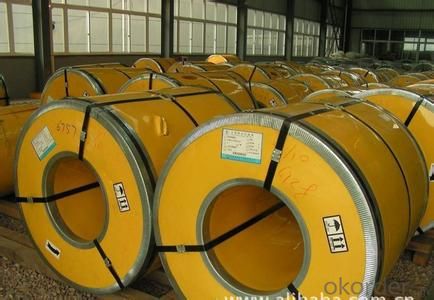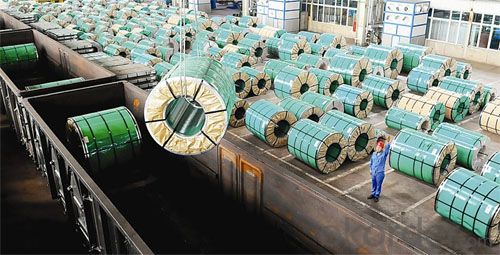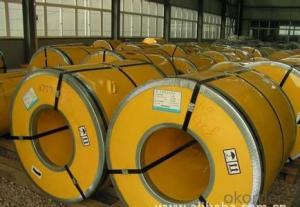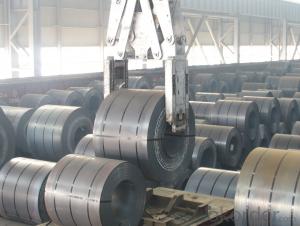Stainless Steel Coil 430 Annealing and Pickling No.1 Finish Hot Rolled
- Loading Port:
- Guangzhou
- Payment Terms:
- TT OR LC
- Min Order Qty:
- 100 m.t.
- Supply Capability:
- 8000 m.t./month
OKorder Service Pledge
OKorder Financial Service
You Might Also Like
Grade: | 400 Series | Standard: | JIS,AISI,ASTM,GB,DIN,EN | Length: | Coil |
Thickness: | 2.5mm,3.0mm, 4.0mm | Width: | 1000mm, 1219mm, 1240mm, 1500mm | Place of Origin: | China Mainland |
Brand Name: | CNBM | Model Number: | 430R | Type: | Coil |
Application: | Element Supports,Stove trim rings,Fasteners,Chimney Liners | Certification: | ISO | Certificate: | ISO9001:2008 |
Surface: | No.1 | Technique: | Hot Rolled | Experience: | About 20 years |
Stock Information: | In stock | Weight per coil: | 18-22 tons | Tolerance: | +/-0.1mm or less |
Model No.: | 430R |
Hot Rolled Stainless Steel Coil 430R No.1 Finish
Article | Hot Rolled Stainless Steel Coil 430R |
Grade | 400 series |
Specification | 1m, 1.2m, 1.5m |
Surface | No.1 |
Type | Sheet / Coil |
Width | 1000mm, 1219mm, 1240mm, 1500mm |
Thickness | 2.5mm,3.0mm, 4.0mm |
Brand name | CNBM |
Parking | seaworthy wooden pallets or wooden cases,in 20' or 40' container or as per customers' requirements |
Payment | 30% in advance,70% after shipping, or L/C at sight |
Delivery Time | Stock materials, within7-15 days after received the deposit of T/T or L/C |
Hot Rolled Stainless Steel Coil 430R No.1 Finish
Grade | C | Cr | Si | Mn | Mo | Ni | P | S |
Max | Max | Max | Max | Max | Max | |||
430R | 0.12 | 16.0-18.0 | 0.75 | 1.00 | ----- | 0.6 | 0.04 | 0.03 |
- Q: What are the different types of coatings available for stainless steel strips?
- There are several different types of coatings available for stainless steel strips, including epoxy coatings, vinyl coatings, polyurethane coatings, and acrylic coatings. These coatings provide protection against corrosion, enhance durability, and improve the aesthetics of stainless steel strips.
- Q: Can stainless steel strips be used for heat exchanger tubes?
- Yes, stainless steel strips can be used for heat exchanger tubes. Stainless steel is a popular choice for heat exchanger applications due to its excellent corrosion resistance, high temperature resistance, and durability. Stainless steel strips can be formed into tubes of various shapes and sizes to accommodate different heat exchanger designs and requirements. Additionally, stainless steel offers good thermal conductivity, allowing for efficient heat transfer in the exchanger. Overall, stainless steel strips are a suitable and commonly used material for heat exchanger tubes.
- Q: What is the magnetic permeability of stainless steel strips?
- The magnetic permeability of stainless steel strips can vary depending on the specific grade and composition. Generally, stainless steel is known for its low magnetic permeability, meaning it does not respond strongly to magnetic fields. This is because of the presence of chromium, which creates a thin oxide layer on the steel's surface and reduces its magnetic properties. However, certain stainless steel grades like 430 and 446 can show slightly higher magnetic permeability than others. In conclusion, the magnetic permeability of stainless steel strips depends on their grade and composition, although stainless steel is not typically considered strongly magnetic.
- Q: Are stainless steel strips suitable for food-grade applications?
- Indeed, stainless steel strips are highly appropriate for food-grade purposes. The exceptional resistance to corrosion, durability, and hygienic characteristics make stainless steel a favored option for food processing and packaging. It neither interacts with food nor modifies its flavor, thereby ensuring the safety and dependability of this material in food-grade applications. In the food industry, stainless steel strips find utility in numerous ways, encompassing the production of equipment, utensils, containers, and storage tanks. Furthermore, stainless steel is effortlessly cleaned and maintained, further solidifying its status as the preferred choice for upholding stringent sanitary standards within food processing environments.
- Q: Can stainless steel strips be used in nuclear power applications?
- Yes, stainless steel strips can be used in nuclear power applications. Stainless steel is a preferred material in the nuclear industry due to its excellent resistance to corrosion, high-temperature strength, and low magnetic permeability. It is commonly used for a range of applications including reactor components, fuel storage containers, heat exchangers, and piping systems. Stainless steel strips offer the advantage of being easily formed into various shapes and sizes, making them suitable for different nuclear power applications. Additionally, stainless steel's ability to withstand radiation damage and its minimal interaction with nuclear fuel further contribute to its suitability in nuclear power applications.
- Q: What are the different surface textures available for stainless steel strips?
- There are several different surface textures available for stainless steel strips, including brushed, polished, embossed, and patterned.
- Q: Can stainless steel strips be used in watchmaking?
- Watchmaking can indeed make use of stainless steel strips. This material is highly favored in the watchmaking industry owing to its exceptional durability, ability to resist corrosion, and attractive appearance. To fashion watch cases, bracelets, and various other parts, stainless steel strips are frequently employed. Its robustness is renowned, making it an appropriate choice for safeguarding the intricate mechanisms within a timepiece. Moreover, stainless steel finds application in both luxury and affordable watches, thus illustrating its versatility as a preferred choice for watchmakers.
- Q: Are 111 stainless steel strips suitable for wastewater treatment pipelines?
- Yes, 111 stainless steel strips are suitable for wastewater treatment pipelines. Stainless steel is known for its corrosion resistance, durability, and high strength, making it an ideal material choice for pipelines in harsh environments like wastewater treatment facilities. The 111 grade stainless steel offers good resistance to corrosion and can withstand the corrosive nature of wastewater, ensuring long-term performance and low maintenance requirements.
- Q: Can 111 stainless steel strips be coated with anti-scratch coatings?
- Yes, 111 stainless steel strips can be coated with anti-scratch coatings.
- Q: What is the difference between hot-rolled and cold-rolled stainless steel strips?
- Hot-rolled and cold-rolled stainless steel strips refer to two different methods of manufacturing stainless steel strips, each with distinct characteristics and applications. Hot-rolled stainless steel strips are produced by heating stainless steel slabs or billets above their recrystallization temperature and then passing them through a series of rollers to achieve the desired thickness. This process results in a strip with a rough surface finish and a scaled or oxidized outer layer. Hot-rolled strips are known for their strength and durability, making them suitable for applications that require high tensile strength and resistance to deformation, such as structural components, automotive parts, and machinery. On the other hand, cold-rolled stainless steel strips are manufactured by taking hot-rolled strips and further processing them through a cold reduction mill. This involves passing the strips through a number of rollers at room temperature to decrease their thickness and improve their surface finish. Cold-rolled strips have a smoother, more polished appearance and a tighter dimensional tolerance compared to hot-rolled strips. They are commonly used in applications that demand a higher level of surface finish, precision, and flatness, such as consumer appliances, kitchenware, and decorative elements. Another significant difference between hot-rolled and cold-rolled stainless steel strips is their mechanical properties. Hot-rolled strips have a lower yield strength and higher ductility, which means they are more prone to deformation and can be easily shaped or formed. Cold-rolled strips, on the other hand, have a higher yield strength and lower ductility, making them less malleable but more resistant to deformation. This makes cold-rolled strips ideal for applications that require precise dimensions and tight tolerances. In conclusion, the main differences between hot-rolled and cold-rolled stainless steel strips lie in their surface finish, dimensional tolerance, mechanical properties, and applications. Hot-rolled strips are characterized by their rough surface finish, high strength, and suitability for structural applications, while cold-rolled strips have a smoother surface finish, tighter dimensional tolerance, and are often used in applications that demand precision and aesthetics.
Send your message to us
Stainless Steel Coil 430 Annealing and Pickling No.1 Finish Hot Rolled
- Loading Port:
- Guangzhou
- Payment Terms:
- TT OR LC
- Min Order Qty:
- 100 m.t.
- Supply Capability:
- 8000 m.t./month
OKorder Service Pledge
OKorder Financial Service
Similar products
Hot products
Hot Searches
Related keywords





























